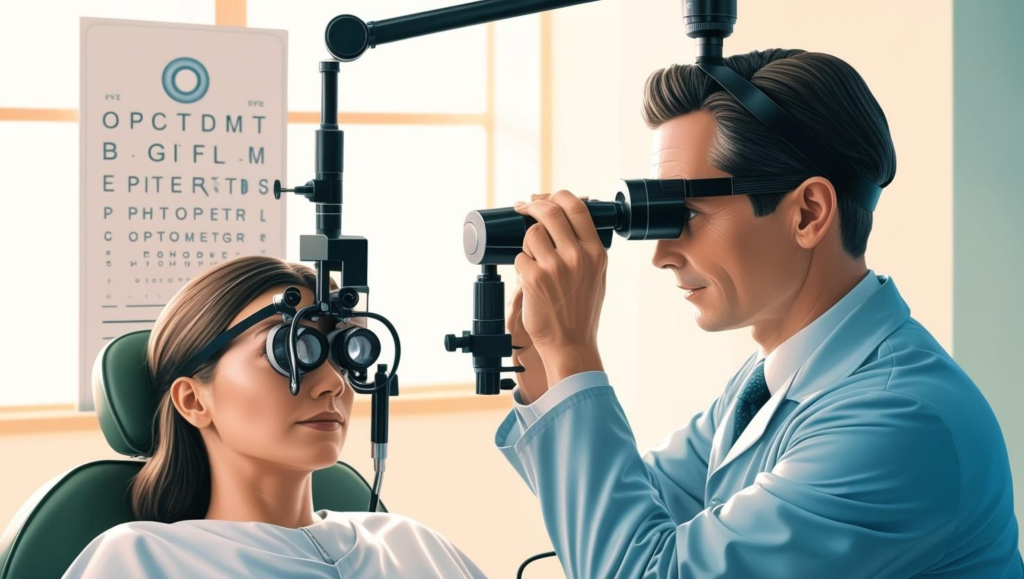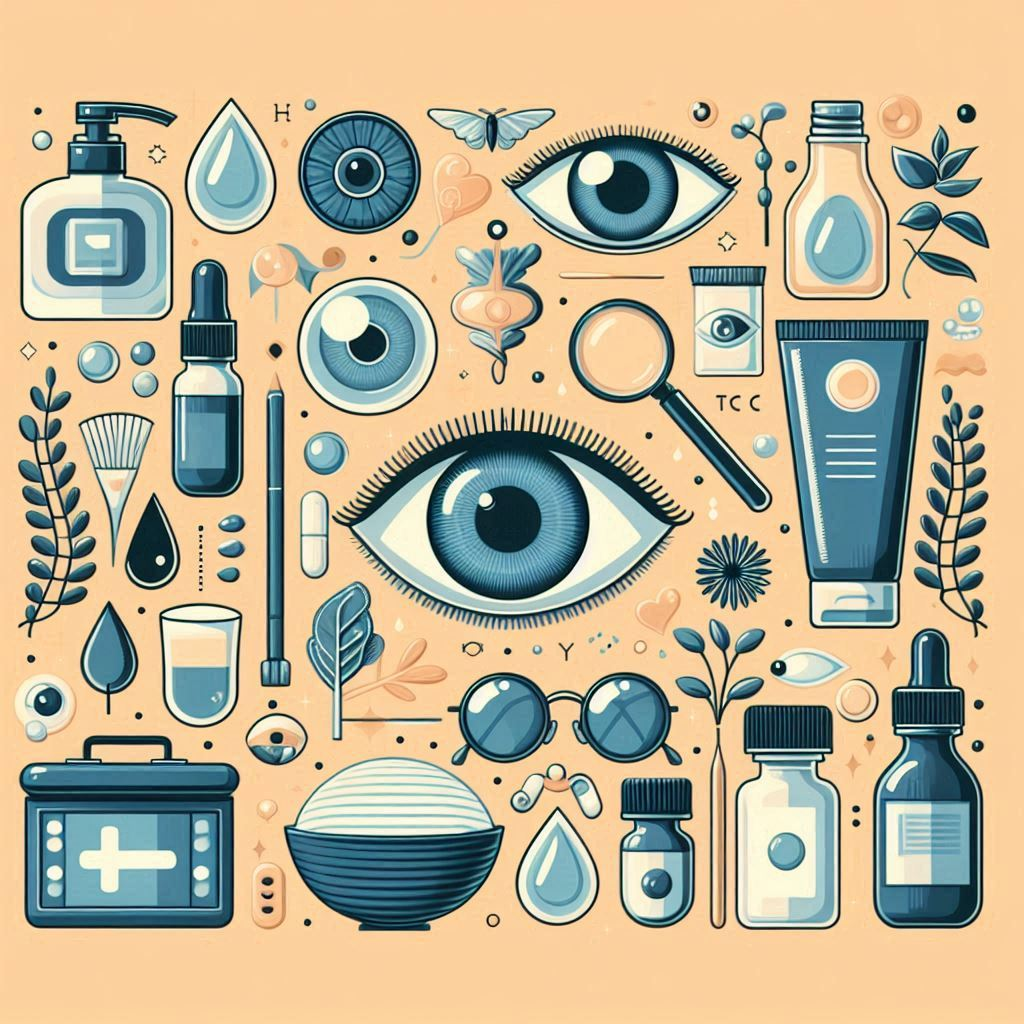Discover essential eye care routines for maintaining your vision and promoting lifelong health with clear sight.

Eye care is essential for overall well-being, and understanding its importance can significantly enhance your quality of life.
Table of Contents

Eye Care Routine
Vision Care Essentials for 20/20 Clarity
Good eye care is one of the most precious gifts, yet it’s often taken for granted until problems arise. Maintaining healthy vision and achieving 20/20 clarity requires more than just occasional check-ups—it demands consistent eye care and attention. In this article, we’ll explore five essential routines for optimal eye health, helping you protect your vision and enjoy a lifetime of clear perception.
Introduction
Incorporating eye care into your daily activities can significantly impact your overall vision.
Importance of Maintaining Good Health
Your vision is your window to the world, and its health is crucial for your overall well-being. Poor health can lead to problems, discomfort, and even blindness. With the increasing use of digital devices and environmental factors like UV exposure, taking proactive steps to care for your sight has never been more important.
Overview of the Five Essential Routines
To achieve and maintain 20/20 vision, incorporate these five essential routines into your daily life:
- Regular Eye Exams
- Balanced Nutrition for Eye Health
- Proper Screen Time Management
- Protection from UV Rays and Environmental Damage
- Adequate Rest and Eye Exercises
1. Regular Exams
Regular exams are a cornerstone of maintaining healthy vision. By prioritizing routine check-ups, you can identify and address potential problems before they become serious. Let’s delve into the benefits, scheduling, and how to choose the right optometrist for your needs.
Why Regular Exams Matter
Regular exams are the cornerstone of good health. They help detect problems early, even before symptoms appear, and ensure your vision is functioning optimally.
Establishing an effective eye care routine is crucial for maintaining and improving your eye health.
How Often Should You Get an Exam?
Regular eye care ensures that you are aware of your visual health and can take appropriate action to maintain it.
- Adults (20–40 years): Every 2–3 years.
- Adults (40+ years): Annually.
- Children: First exam at 6 months, then before starting school, and every 2 years thereafter.
What to Expect During an Exam
- Vision acuity test.
- Eye pressure measurement.
- Retinal examination.
- Discussion of any symptoms or concerns.
Regular exams enable the early detection of various conditions such as glaucoma, cataracts, macular degeneration, and diabetic retinopathy. Identifying these issues in their early stages allows for prompt treatment, which can prevent further deterioration and maintain your quality. Early intervention can make a significant difference in managing health and avoiding complications that could lead to loss.
Personalized Eye Care Advice
During an exam, your optometrist can provide personalized advice tailored to your specific needs. This includes recommendations for corrective lenses, contact lens care, or lifestyle adjustments to improve health. Personalized care plans ensure that you are taking the necessary steps to protect and enhance your vision. Your optometrist can also suggest preventive measures and educate you on maintaining optimal health.
Scheduling and Frequency
How Often to Get an Eye Exam
The frequency of exams depends on factors such as age, medical history, and existing conditions. Generally, adults aged 18 to 60 should have an exam every two years. However, individuals over 60 or those with a history of problems may require annual check-ups. Children should have their first exam at six months, another at three years, and then regular assessments before starting school and periodically thereafter.
What to Expect During an Eye Exam
An eye exam typically includes several tests to assess your vision and eye health. These tests may include:
- Visual acuity test: Measures how clearly you see at different distances.
- Refraction test: Determines your exact eyeglass prescription.
- Slit-lamp exam: Allows the optometrist to examine the structures of your eye.
- Tonometry: Measures the pressure inside your eyes to screen for glaucoma.
- Retinal examination: Evaluates the health of your retina and optic nerve.
Your optometrist will discuss the results and provide any necessary recommendations or treatments based on the findings.
Eye Choosing the Right Optometrist
Factors to Consider
Selecting the right optometrist is crucial for receiving quality eye care. Consider the following factors when choosing an optometrist:
- Qualifications and Experience: Ensure the optometrist is licensed and has sufficient experience in eye care.
- Specializations: Some optometrists specialize in areas such as pediatric eye care, geriatric eye care, or contact lenses. Choose one that matches your specific needs.
- Reputation: Check reviews and ask for recommendations from friends or family to find a reputable optometrist.
- Location and Availability: Choose an optometrist whose office is conveniently located and offers flexible appointment times.
Finding a Trusted Professional
To find a trusted optometrist, start by researching online and reading reviews from other patients. You can also ask for recommendations from your primary care physician, friends, or family members. Once you have a list of potential optometrists, schedule consultations to discuss your eye care needs and assess their compatibility with you. A trusted professional will be attentive, knowledgeable, and committed to providing the best care for your eyes.
2. Balanced Nutrition for Eye Health
Key Nutrients for Healthy Eyes
- Vitamin A: Essential for night vision (found in carrots, sweet potatoes).
- Omega-3 Fatty Acids: Support retinal health (found in fish, flaxseeds).
- Lutein and Zeaxanthin: Protect against macular degeneration (found in leafy greens, eggs).
- Vitamin C and E: Antioxidants that prevent oxidative damage (found in citrus fruits, nuts).
Foods to Include in Your Diet
- Leafy greens (spinach, kale).
- Fatty fish (salmon, mackerel).
- Brightly colored fruits and vegetables (oranges, bell peppers).
- Nuts and seeds (almonds, chia seeds).
Eye supplements can play a significant role in maintaining and improving vision health, especially when dietary intake of essential nutrients is insufficient. Let’s explore when and why to consider supplements and the importance of consulting with a healthcare provider.
When and Why to Consider Supplements
Nutrient Deficiencies: If your diet lacks essential nutrients that support eye health, such as vitamins A, C, E, zinc, and omega-3 fatty acids, supplements can help fill the gap. These nutrients are crucial for maintaining healthy vision and preventing eye conditions.
Age-Related Eye Conditions: As we age, the risk of developing eye conditions like age-related macular degeneration (AMD), cataracts, and glaucoma increases. Supplements containing antioxidants, lutein, zeaxanthin, and omega-3 fatty acids can help reduce the risk and progression of these conditions.
High Screen Time: Prolonged exposure to screens can strain the eyes and lead to digital eye strain. Supplements with ingredients like lutein and zeaxanthin can help protect the eyes from blue light and reduce oxidative stress.
Dry Eyes: For individuals experiencing dry eyes, omega-3 fatty acids found in fish oil supplements can help maintain eye moisture and reduce inflammation.
Preventive Measures: Even if you don’t have existing eye conditions, taking supplements as a preventive measure can support overall eye health and protect against potential future issues.
Consulting with a Healthcare Provider
Personalized Recommendations: Consulting with a healthcare provider, such as an optometrist or ophthalmologist, is essential before starting any supplement regimen. They can assess your specific eye health needs and recommend the most appropriate supplements based on your individual condition.
Avoiding Overdose: Excessive intake of certain vitamins and minerals can have adverse effects. A healthcare provider can help you determine the right dosage to avoid potential risks and ensure you receive the maximum benefits from the supplements.
Evaluating Interactions: Supplements can interact with medications or other supplements you may be taking. A healthcare provider can evaluate potential interactions and provide guidance on safe and effective use.
Monitoring Progress: Regular check-ups with a healthcare provider allow for monitoring the effectiveness of the supplements and making any necessary adjustments to your regimen. This ensures that your eye health is continuously supported and optimized.
Hydration and Eye Health
Eye Importance of Hydration for Eye Health
Proper hydration is crucial for maintaining overall health, including eye health. Water plays a vital role in various bodily functions, including the production of tears, which are essential for keeping the eyes moist and comfortable. Let’s explore how dehydration affects eye function and the symptoms of dry eyes due to lack of hydration.
How Dehydration Affects Eye Function
Dehydration can significantly impact eye function by reducing tear production, leading to dry and irritated eyes. Tears are composed of water, oils, and mucus, and they provide essential lubrication to the eyes’ surface. When the body lacks sufficient water, it prioritizes other vital functions over tear production, resulting in dry eyes. This lack of moisture can cause discomfort, itching, redness, and even blurred vision.
Dehydration also affects the balance of electrolytes in the body, which can further exacerbate dry eye symptoms. Electrolytes, such as sodium and potassium, help maintain the proper function of cells and tissues, including those in the eyes. Imbalances in electrolytes can disrupt the eye’s natural moisture balance, making it more difficult to maintain healthy, hydrated eyes.
Symptoms of Dry Eyes Due to Lack of Hydration
Dry eyes caused by dehydration can present a range of symptoms, including:
- Irritation and Itching: The eyes may feel gritty or itchy, leading to frequent rubbing and discomfort.
- Redness: Lack of moisture can cause the eyes to become red and inflamed.
- Sensitivity to Light: Dry eyes can make the eyes more sensitive to light, causing discomfort in bright environments.
- Blurred Vision: Insufficient tear production can lead to blurry or fluctuating vision.
- Feeling of Something in the Eye: Dryness can create a sensation of having a foreign object in the eye, known as “foreign body sensation.”
- Excessive Tearing: Paradoxically, dry eyes may trigger excessive tearing as the body attempts to compensate for the lack of moisture.
Eye Tips for Staying Hydrated
Maintaining proper hydration is essential for preventing dry eyes and promoting overall eye health. Here are some tips for staying hydrated:
Recommended Daily Water Intake
The amount of water needed daily can vary based on factors such as age, gender, activity level, and climate. However, a general guideline is to drink at least eight 8-ounce glasses of water per day, commonly known as the “8×8 rule.” This equates to about 2 liters or half a gallon of water daily. It’s important to listen to your body and adjust your water intake based on your individual needs and circumstances.
Hydrating Foods and Beverages
In addition to drinking water, consuming hydrating foods and beverages can help maintain optimal hydration levels. Some hydrating foods and beverages include:
- Water-Rich Fruits and Vegetables: Foods like cucumbers, watermelon, oranges, strawberries, and lettuce have high water content and can contribute to overall hydration.
- Herbal Teas: Herbal teas, such as chamomile or peppermint, can provide hydration without added sugars or caffeine.
- Soups and Broths: These can be a nutritious and hydrating option, especially during colder months.
- Smoothies: Blending fruits and vegetables into smoothies is a delicious way to boost hydration and nutrient intake.
Eye Using Artificial Tears
Artificial tears can be a valuable tool for managing dry eyes, especially when natural tear production is insufficient. Here are some guidelines for using artificial tears effectively:
When to Use Artificial Tears
Artificial tears can be used whenever you experience symptoms of dry eyes, such as irritation, redness, or discomfort. They are especially beneficial in situations that can exacerbate dryness, such as prolonged screen time, exposure to air conditioning or heating, and windy or dry environments. Regular use of artificial tears can help maintain eye moisture and prevent discomfort.
Choosing the Right Type of Eye Drops
There are various types of artificial tears available, and choosing the right one depends on your specific needs. Here are some options:
- Preservative-Free Drops: These are ideal for individuals with sensitive eyes or those who need to use drops frequently. Preservative-free drops come in single-use vials to avoid contamination.
- Lubricating Drops: These drops provide long-lasting moisture and are suitable for moderate to severe dry eye symptoms.
- Gel Drops: Gel-based drops offer thicker, longer-lasting relief and are ideal for use before bedtime.
- Redness-Relief Drops: These drops contain vasoconstrictors that temporarily reduce eye redness. However, they are not recommended for long-term use as they can cause rebound redness.
Consulting with an eye care professional can help you determine the most appropriate artificial tears for your specific condition and ensure you receive the best care for your eyes.
3. Proper Screen Time Management
H3: The Impact of Digital Devices on Eye Health
Prolonged screen time can lead to digital eye strain, characterized by symptoms like dry eyes, blurred vision, and headaches.
Tips to Reduce Eye Strain
- Follow the 20-20-20 rule: Every 20 minutes, look at something 20 feet away for 20 seconds.
- Adjust screen brightness and contrast to reduce glare.
- Use blue light filters or glasses.
- Position your screen at eye level and at a comfortable distance.
Importance of Blinking
Blinking helps lubricate the eyes and prevent dryness. Make a conscious effort to blink more often while using screens.
Protecting Eyes During Physical Activities
Eye Safety Gear for Sports and Outdoor Activities
Protecting your eyes during sports and outdoor activities is crucial to prevent injuries and maintain healthy vision. Here’s a detailed look at the types of protective eyewear for different sports, the importance of wearing eye protection, and essential precautions for home projects and managing environmental factors.
Types of Protective Eyewear for Different Sports
Basketball and Racquet Sports:
- Goggles: These should be made of polycarbonate lenses, which are impact-resistant and provide excellent protection against fast-moving objects and fingers.
Cycling:
- Cycling Glasses: Designed to protect against wind, debris, and UV rays, cycling glasses often come with interchangeable lenses for different lighting conditions.
Football and Rugby:
- Face Shields and Goggles: Face shields are attached to helmets, while goggles provide additional eye protection.
Swimming:
- Swim Goggles: These protect the eyes from chlorine and other chemicals in the water, as well as from potential bacterial infections.
Skiing and Snowboarding:
- Ski Goggles: These provide protection from wind, snow, and UV rays. Look for anti-fog lenses for better visibility.
Baseball and Softball:
- Sports Goggles: Polycarbonate lenses offer protection against fast-moving balls and accidental hits.
Hockey:
- Full Face Masks and Shields: These provide comprehensive protection against pucks, sticks, and collisions.
Importance of Wearing Eye Protection
Wearing protective eyewear during sports and outdoor activities is essential for several reasons:
- Preventing Injuries: Eye injuries can range from minor irritations to severe trauma that could result in vision loss. Protective eyewear significantly reduces the risk of such injuries.
- Enhancing Performance: Clear vision is vital for peak performance in sports. Protective eyewear ensures that you maintain optimal vision while protecting your eyes.
- UV Protection: Many outdoor sports expose your eyes to harmful UV rays. Specialized sports eyewear often includes UV protection to shield your eyes from these rays.
- Comfort and Safety: Protective eyewear designed specifically for sports offers a comfortable fit and stays in place during vigorous activities, ensuring both safety and ease of use.
Eye Precautions for DIY and Home Projects
Engaging in DIY and home improvement projects can expose your eyes to various hazards. Taking proper precautions is essential for eye safety.
Eye Safety Tips for Home Improvement Tasks
- Wear Safety Goggles: Always wear safety goggles when using power tools, hammering, sanding, or working with chemicals. Choose goggles that fit snugly and offer side protection.
- Keep Tools in Good Condition: Regularly inspect and maintain your tools to ensure they function properly and safely.
- Follow Instructions: Carefully read and follow the instructions for all tools and materials to avoid accidents.
- Work in Well-Ventilated Areas: Proper ventilation reduces the risk of exposure to fumes and dust, which can irritate your eyes.
- Clear Your Workspace: Remove any clutter or obstacles to minimize the risk of tripping or accidents that could affect your eyes.
Using Appropriate Protective Gear
Selecting the right protective gear is crucial for eye safety during DIY projects:
- Face Shields: For tasks that involve flying debris, such as grinding or cutting metal, use a face shield along with safety goggles for maximum protection.
- Chemical Splash Goggles: When working with chemicals, wear goggles specifically designed to prevent splashes from reaching your eyes.
- Respirators and Masks: Use respirators or masks to protect your respiratory system and reduce the risk of inhaling particles that could irritate your eyes.
Eye Managing Environmental Factors
Environmental factors such as wind, dust, and allergens can affect your eye health. Here are some tips for managing these elements:
Protecting Eyes from Wind, Dust, and Allergens
- Wear Wraparound Sunglasses: These provide better protection from wind, dust, and allergens by covering the sides of your eyes.
- Use Eye Drops: Lubricating eye drops can help alleviate dryness and irritation caused by environmental factors.
- Stay Indoors During High Allergen Periods: When pollen counts are high, try to stay indoors as much as possible to reduce exposure to allergens.
Using Eye Protection in Various Settings
- Outdoor Activities: For activities like hiking or cycling, wear sunglasses with UV protection and wraparound features to shield your eyes from environmental elements.
- Gardening: Use safety goggles to protect your eyes from soil, debris, and plant allergens.
- Traveling: When traveling, especially in dusty or windy conditions, wear protective eyewear to prevent irritation and potential eye injuries.
Eye Workplace Safety
Protecting your eyes in the workplace is crucial, especially in environments with potential hazards. Here are some guidelines for using protective gear and setting up ergonomic workspaces for prolonged computer use.
Protective Gear for Hazardous Environments
In workplaces with physical hazards, such as construction sites, laboratories, or manufacturing plants, using appropriate eye protection is essential:
- Safety Glasses: Safety glasses with side shields protect against flying debris, dust, and chemical splashes. Choose glasses with impact-resistant lenses made of polycarbonate.
- Goggles: For tasks involving chemicals, dust, or liquids, use goggles that provide a secure seal around the eyes, preventing contaminants from entering.
- Face Shields: When performing tasks that generate high-impact particles or splashes, use a face shield in addition to safety glasses or goggles. Face shields offer full-face protection against flying debris and hazardous materials.
- Welding Helmets: For welding tasks, use a helmet with a proper shade filter to protect against intense light and radiation. Ensure the helmet fits securely and provides adequate coverage.
Ergonomic Setups for Prolonged Computer Use
Spending long hours in front of a computer screen can strain your eyes and lead to digital eye strain. Here are some tips for setting up an ergonomic workspace:
- Monitor Position: Position your monitor at eye level, about 20-30 inches away from your eyes. The top of the screen should be at or slightly below eye level to reduce neck strain.
- Lighting: Ensure your workspace is well-lit, with minimal glare on the screen. Use adjustable lighting to avoid harsh contrasts between the screen and surrounding environment.
- Anti-Glare Screens: Consider using an anti-glare screen protector to reduce reflections and glare from overhead lighting or windows.
- Frequent Breaks: Follow the 20-20-20 rule: every 20 minutes, take a 20-second break to look at something 20 feet away. This helps reduce eye strain and relaxes your eye muscles.
- Adjustable Chairs and Desks: Use ergonomic chairs and adjustable desks to maintain proper posture and support. Ensure your chair provides adequate lumbar support and allows your feet to rest flat on the floor.
H3: Eye First Aid for Eye Injuries
Eye injuries can occur unexpectedly and may require immediate attention. Knowing how to respond to common eye injuries and when to seek professional help is crucial for minimizing damage and ensuring proper treatment.
Common Injuries and Immediate Actions
Foreign Objects:
- Action: Do not rub your eyes. Rinse the eye with clean water or saline solution to flush out the object. If the object remains, seek medical attention.
Chemical Splashes:
- Action: Immediately flush the eye with water for at least 15 minutes. Use a gentle stream of water from a faucet or eyewash station. Seek medical help immediately after rinsing.
Cuts or Punctures:
- Action: Do not attempt to remove any embedded objects. Cover the eye with a clean, sterile cloth or eye shield. Seek emergency medical care immediately.
Blunt Trauma:
- Action: Apply a cold compress to reduce swelling and pain. Avoid applying pressure to the eye. If there is severe pain, vision changes, or blood in the eye, seek medical attention promptly.
When to Seek Professional Help
Certain injuries require immediate medical attention to prevent long-term damage. Seek professional help if you have experience:
- Severe Pain: Intense or persistent eye pain that does not improve with initial first aid measures.
- Vision Changes: Sudden changes in vision, such as blurriness, double vision, or loss of vision.
- Bleeding: Any bleeding from the eye or blood visible in the white part of the eye.
- Foreign Objects: If you cannot remove a foreign object from the eye or if it is embedded.
- Chemical Exposure: Exposure to chemicals, especially if rinsing does not alleviate symptoms.
4. Protection from UV Rays and Environmental Damage
The Dangers of UV Exposure
Prolonged exposure to UV rays can increase the risk of cataracts, macular degeneration, and other eye conditions. Protecting your eyes from harmful ultraviolet (UV) rays is essential for maintaining long-term eye health. UV rays from the sun can cause various eye conditions, including cataracts, macular degeneration, and photo-keratitis. Here’s a closer look at the importance of sunglasses and choosing the right UV-blocking eye wear.
How to Protect Your Eyes
Importance of Sunglasses
By prioritizing these routines, you can ensure that your health remains sharp. Remember, your eyes are precious, and taking proactive steps to care for them will pay off eventually. Make health a priority and enjoy the benefits of clear and vibrant vision.
- Protection Against UV Rays: UV radiation from the sun can damage the eyes’ delicate tissues, leading to conditions such as cataracts, macular degeneration, and photo-keratitis (sunburn of the eye). Sunglasses with UV protection help block these harmful rays and reduce the risk of eye damage.
- Preventing Eye Strain: Sunglasses reduce glare from the sun, making it easier to see in bright conditions and preventing eye strain.
- Reducing Risk of Eye Cancer: Prolonged exposure to UV rays increases the risk of developing cancerous growths on the eye’s surface. Wearing sunglasses helps protect against this risk.
- Shielding Against Environmental Factors: Sunglasses provide a physical barrier that protects your eyes from wind, dust, and debris, reducing the likelihood of irritation and injury.
- Wear sunglasses with 100% UV protection.
- Use wide-brimmed hats for added shade.
- Avoid direct sunlight during peak hours (10 a.m. to 4 p.m.).
Protecting Eyes from Environmental Factors
- Use protective eyewear during activities like swimming or working with hazardous materials.
- Keep your eyes clean and avoid rubbing them with dirty hands.
Choosing UV-Blocking Eyewear
When selecting sunglasses, it’s essential to ensure they offer adequate UV protection. Here are some tips for choosing the right UV-blocking eyewear:
- Look for UV Protection Labels: Choose sunglasses that block 100% of both UVA and UVB rays. Check for labels indicating “UV400” or “100% UV protection.”
- Consider Lens Color and Material: While lens color and material don’t necessarily affect UV protection, they can impact comfort and visibility. Gray lenses offer the most natural color perception, while brown and amber lenses enhance contrast. Polycarbonate lenses are lightweight and impact-resistant, making them ideal for sports and outdoor activities.
- Wraparound Styles: Wraparound sunglasses provide additional coverage by blocking UV rays from entering the sides of the eyes. This design is particularly useful for outdoor activities where you may be exposed to intense sunlight from various angles.
- Polarized Lenses: Polarized lenses reduce glare from reflective surfaces like water and roads, enhancing visibility and comfort. While polarization doesn’t provide UV protection on its own, many polarized lenses also include UV-blocking features.
- Fit and Comfort: Ensure the sunglasses fit well and are comfortable to wear for extended periods. The frames should not pinch your nose or ears, and the lenses should fully cover your eyes without obstructing your vision.
5. Adequate Rest and Eye Exercises
Importance of Sleep for Eye Health
Adequate sleep allows your eyes to rest and repair, reducing the risk of dryness and irritation.
Simple Eye Exercises to Improve Vision
- Palming: Rub your hands together to generate warmth, then place them over your closed eyes for a few minutes.
- Focus Shifting: Alternate focus between a near object and a distant object.
- Eye Rolling: Roll your eyes in a circular motion to relax the eye muscles.
Creating a Relaxing Eye Care Routine
- Practice eye exercises daily.
- Use warm compresses to soothe tired eyes.
- Ensure your workspace is well-lit to reduce strain.
Regular Eye Exercises
Regular eye exercises can play a crucial role in maintaining and improving your eye health. They help enhance focus, flexibility, and reduce eye strain. Let’s delve into the benefits of eye exercises, simple practices to try, and how to track progress.
Improving Focus and Flexibility
Eye exercises can significantly improve your eye muscles’ focus and flexibility. Just like any other muscle in the body, the eye muscles can become more efficient with regular training. Enhanced focus helps in better control of eye movements, allowing for clearer and sharper vision. Improved flexibility aids in adjusting your eyes more effectively to different distances and lighting conditions, thus reducing the likelihood of eye strain.
Reducing Eye Strain
Prolonged periods of screen time or tasks requiring intense visual concentration can lead to eye strain. Eye exercises can alleviate this strain by giving your eyes regular breaks and promoting relaxation. These exercises help reduce fatigue and discomfort associated with activities such as reading, working on a computer, or driving for extended periods.
Palming
Palming is a simple yet effective exercise to relax your eyes. Here’s how to do it:
- Sit comfortably and rub your hands together to generate warmth.
- Close your eyes and place your warmed palms over them without applying pressure.
- Ensure no light enters your eyes and hold this position for a few minutes while breathing deeply and relaxing.
Focusing
Focusing exercises can improve your eye’s ability to switch between near and far objects. Try this:
- Hold a small object (like a pen) at arm’s length.
- Focus on the object and slowly bring it closer to your nose.
- Once it’s close enough that you see it clearly, slowly move it back to arm’s length.
- Repeat this process several times.
Figure Eight
This exercise helps improve your eyes’ flexibility and control:
- Imagine a large figure eight lying on its side about 10 feet in front of you.
- Slowly trace the figure eight with your eyes without moving your head.
- Trace it in one direction for a few minutes, then switch to the opposite direction.
How to Incorporate Exercises into Your Routine
Incorporating eye exercises into your daily routine can be easy and convenient:
- Morning Routine: Start your day with a few minutes of eye exercises to wake up your eyes and prepare them for the day’s activities.
- During Breaks: Take short breaks throughout your workday to perform eye exercises, especially if you spend long hours in front of a screen.
- Evening Routine: End your day with relaxation exercises like palming to ease any accumulated eye strain before going to bed.
Consistency is key to seeing the benefits of these exercises, so try to incorporate them into your routine regularly.
Eye Tracking Progress
Monitoring Improvements
To track your progress with eye exercises, consider keeping a journal where you note any changes in your vision or comfort levels. Record the exercises you perform, the duration, and any noticeable improvements or challenges. This can help you stay motivated and identify patterns in your eye health.
Adjusting Exercises as Needed
As you become more comfortable with eye exercises, you may need to adjust the intensity or variety to continue challenging your eye muscles. If you experience any discomfort or lack of progress, consult with an eye care professional for personalized advice and adjustments to your routine. They can provide guidance on specific exercises tailored to your needs and ensure you perform them correctly.
Conclusion
Maintaining good eye health is essential for enjoying clear and comfortable vision throughout your life. By incorporating these five essential eye care routines into your daily habits, you can protect and enhance your eyesight:
- Regular Eye Exams: Schedule routine check-ups to detect and address potential eye conditions early on, and receive personalized eye care advice.
- Balanced Diet and Nutrition: Consume a diet rich in vitamins, nutrients, and omega-3 fatty acids to support optimal eye health.
- Proper Eye Hygiene and Care: Practice daily hygiene habits, protect your eyes from digital strain, and choose the right eyewear for your needs.
- Regular Eye Exercises: Improve focus, flexibility, and reduce eye strain by incorporating simple eye exercises into your routine.
- Protecting Eyes from Harm: Shield your eyes from UV rays, use protective gear in hazardous environments, and follow safety measures to prevent injuries.
By prioritizing these routines, you can ensure that your eyes remain healthy, and your vision stays sharp. Remember, your eyes are precious, and taking proactive steps to care for them will pay off eventually. Make eye health a priority and enjoy the benefits of clear and vibrant vision.
Taking the time for proper eye care can prevent many visual impairments.
Remember that your daily habits contribute to your long-term eye care.
Prioritizing eye care will lead to enhanced vision and overall health.


